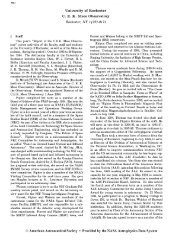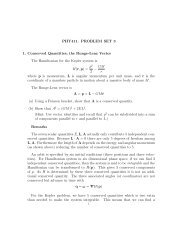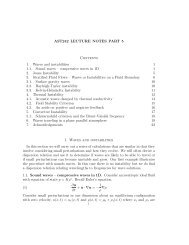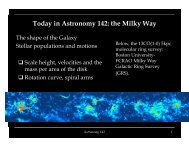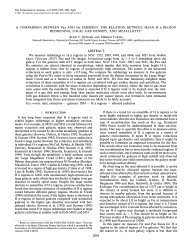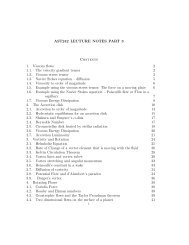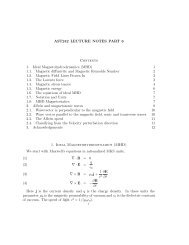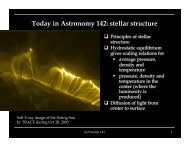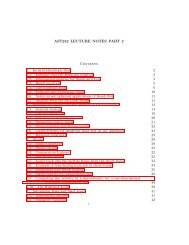Physics of Music PHY103 Worksheet #1 Set up for Lab #1
Physics of Music PHY103 Worksheet #1 Set up for Lab #1
Physics of Music PHY103 Worksheet #1 Set up for Lab #1
Create successful ePaper yourself
Turn your PDF publications into a flip-book with our unique Google optimized e-Paper software.
<strong>Physics</strong> <strong>of</strong> <strong>Music</strong> <strong>PHY103</strong> <strong>Worksheet</strong> <strong>#1</strong><br />
<strong>Set</strong> <strong>up</strong> <strong>for</strong> <strong>Lab</strong> <strong>#1</strong><br />
1) Definition <strong>of</strong> frequency and period. A sine wave can be described by the<br />
function f ( t) = Asin( ωt) = Asin(2 π ft)<br />
<strong>of</strong> time t. Here A is the amplitude, ω is<br />
the angular frequency and f is the frequency. The frequency, f, is given in units <strong>of</strong><br />
Hertz (Hz) or cycles/second (same thing) when the time, t, is in seconds. The<br />
angular frequency is in units <strong>of</strong> radians per second. There are 2π radians or 360<br />
degrees in a circle. Remember that sin(0) = 0 , sin( π / 2) = 1 , sin( π ) = 0 ,<br />
sin(3 π / 2) = −1and sin(2 π ) = 0 .<br />
Period<br />
a) What is the frequency in Hz <strong>of</strong> the sine wave shown above?<br />
b) What is the period in seconds <strong>of</strong> the sine wave?<br />
c) What is the amplitude <strong>of</strong> the sine wave?<br />
d) What would be the <strong>for</strong>mula f(t) <strong>for</strong> a sine function that has twice the amplitude <strong>of</strong><br />
the above wave and a frequency <strong>of</strong> 1000 Hz?
2) Accuracy<br />
a) S<strong>up</strong>pose you have a counter that measures frequency in Hz. It only measures<br />
integer values. S<strong>up</strong>pose you have a signal that is 300Hz. Since it only measures Hz<br />
in integer values the measurement would have an error <strong>of</strong> at least 1 Hz or a fractional<br />
error <strong>of</strong> 1/300=0.0033 or 0.33%. What fractional error would you get if you measured<br />
a 10Hz signal? A 100kHz signal?<br />
b) S<strong>up</strong>pose you measure frequency on the oscilloscope and you adjust the time axis<br />
so that 1 period <strong>of</strong> the signal covers 2 boxes on the scope. The error in measurement<br />
you estimate from the screen by eye would be approximately 1/5 box or 1/10 <strong>of</strong> a<br />
period. How accurately can you measure the frequency <strong>of</strong> a 10kHz signal? How<br />
accurately can you measure the frequency <strong>of</strong> a 1kHz signal?<br />
3) Practicing unit conversion.<br />
S<strong>up</strong>pose I want to convert 6 inches into cm. 1 inch = 2.54cm. I can remember that<br />
cm are smaller and so I want a bigger number. This means that I multiply by 2.54.<br />
2.54 cm<br />
Or I could write the problem like this 6 inches × = 15.24cm . Note that the<br />
inches<br />
inches cancel on the left hand side in this operation. If I write the problem this way<br />
then I don’t need to think too hard about whether to divide or multiply by 2.54.<br />
inches<br />
S<strong>up</strong>pose I want to convert 10 cm into inches. 10cm × = 3.94inches . Note the<br />
2.54 cm<br />
cm cancel in the operation.<br />
a) The speed <strong>of</strong> sound is approximately 742 miles/hour. Convert this into metric units<br />
<strong>of</strong> cm/s. Hint (This requires converting the miles into inches and the inches into cm.<br />
The hours must be converted to minutes and the minutes into seconds.) 1 mile is<br />
equivalent to 63 360 inches.




